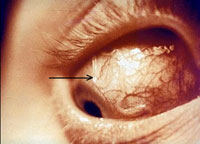Tourist in Africa Finds White Worms in Her Eyes
A female Russian tourist, who lived in Equatorial Guinea for six months, will have to undergo treatment for an exotic disease known as loiasis.

The woman arrived in the African country last winter. Six months later, she found a small white tumor on her shoulder. The tumor was 3-4 centimeters in diameter. The tumor disappeared in two days, but later reappeared on the woman’s head. Afterwards, the tumor was moving from one spot on the woman’s body to another for several months.
The woman eventually stopped paying attention to it until she felt sharp pain in her right eye. She looked in the mirror and was shocked to see a white worm crawling from one corner of her eye to the other. The helmint disappeared, but the woman found it the next day, underneath her lower eyelid.
The tourist decided to return to Russia to undergo medical treatment in Moscow. The woman caught the tropical disease known as loiasis. The moving tumor, which the woman had on her body, is known as the Calabar swelling: it is a typical symptom of loiasis.
Loiasis is a parasitic disease caused by a certain type of helmint known as Loa loa. The disease transmits through the bite of deer fly or mango fly. Incidents when worms penetrate into the brain or the spinal cord may lead to lamentable consequences. An infected individual may develop a severe form of encephalitis.
The geographical distribution of human loiasis is restricted to the rain forest and swamp forest areas of West Africa, being especially common in Cameroon and on the Ogowe River. Humans are the only known natural reservoir. It is estimated that 12-13 million humans are infected with the Loa loa larvae.
An area of tremendous concern regarding loiasis is its co-endemicity with onchocerciasis in certain areas of west and central Africa, as mass ivermectin treatment of onchocerciasis can lead to serious adverse events (SAEs) in patients who have high Loa loa microfilarial densities, or loads. This fact necessitates the development of more specific diagnostics tests for Loa loa so that areas and individuals at a higher risk for neurologic consequences can be identified prior to microfilaricidal treatment. Additionally, the treatment of choice for loiasis, diethylcarbamazine, can lead to serious complications in and of itself when administered in standard doses to patients with high Loa loa microfilarial loads.
It is not the only tragic incident that occurred to Russian tourists in Africa.
A Russian woman was hospitalized in a critical condition in the South African Republic after she had been bitten by a green mamba.
An elderly woman, who supposedly arrived in South Africa from Russia’s Siberia, is currently fighting for her life at a hospital in KwaZulu-Natal. The woman was bitten by a green mamba twice, paramedics said.
The woman was crossing the road near a local trade center, when a car that was passing by ran over the green snake that had crawled onto the roadway. The reptile bit the woman in her shin twice, Turprom website reports with reference to Times Live.
The woman was in a critical condition when paramedics arrived: the snake’s cytotoxic and heamotoxic venom had already taken effect. The police killed the reptile and identified it.
The woman was airlifted to the Netcare St Umhlanga hospital.
The eastern green mamba or common mamba (Dendroaspis angusticeps) is a venomous arboreal snake indigenous to the eastern side of southern Africa. Eastern green mambas are the smallest members of the mamba family, averaging 1.8 metres (5.9 feet), with known specimens to 3.7 m (12 feet). The species is found in forests chiefly near the coast stretching from the Eastern Cape in South Africa through Mozambique and Tanzania as far as south-east Kenya, going inland as far as southern Malawi and eastern Zimbabwe. Any bite from a green mamba is potentially fatal and should be regarded as a medical emergency requiring immediate hospital treatment.
Subscribe to Pravda.Ru Telegram channel, Facebook, RSS!


